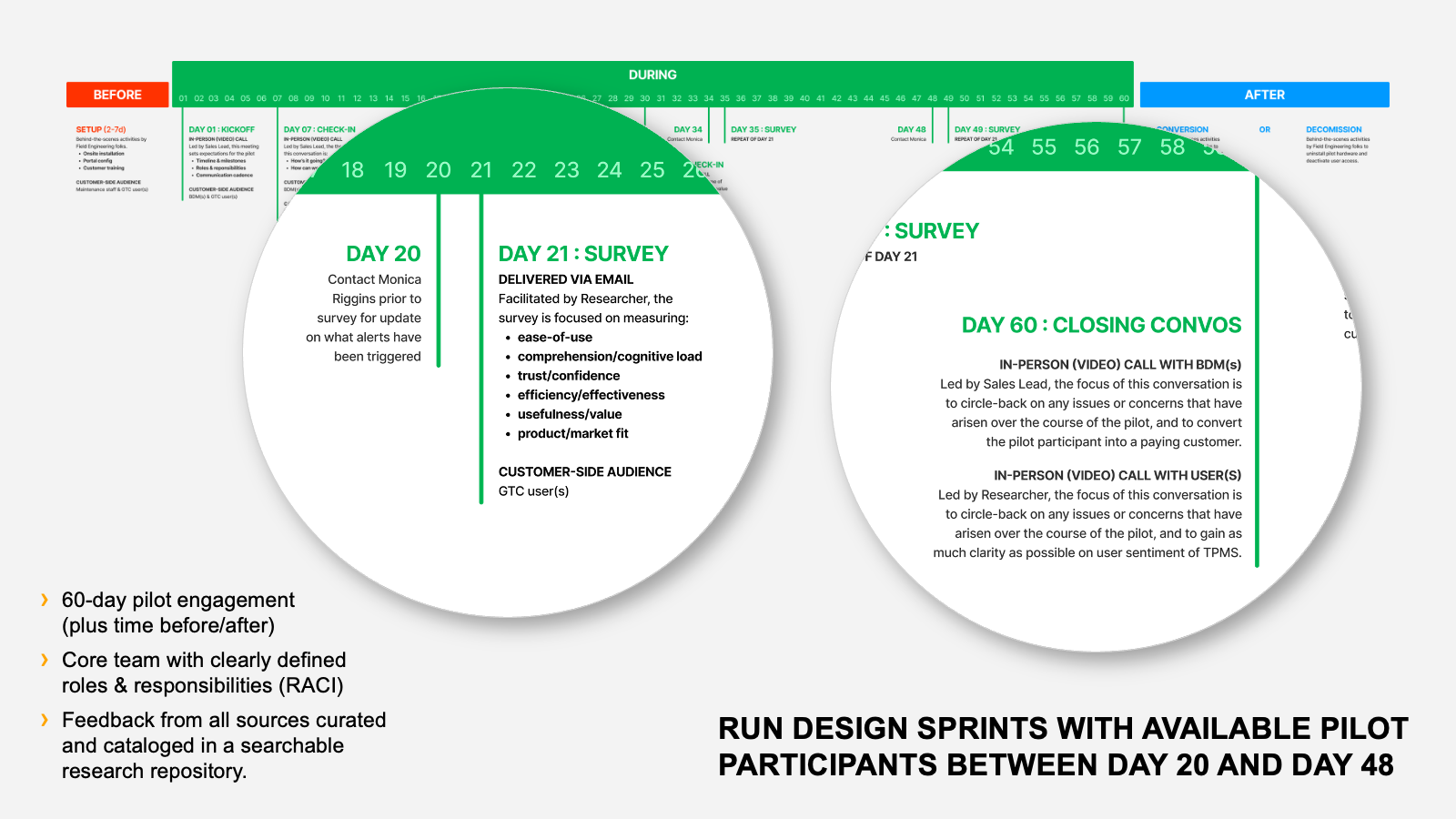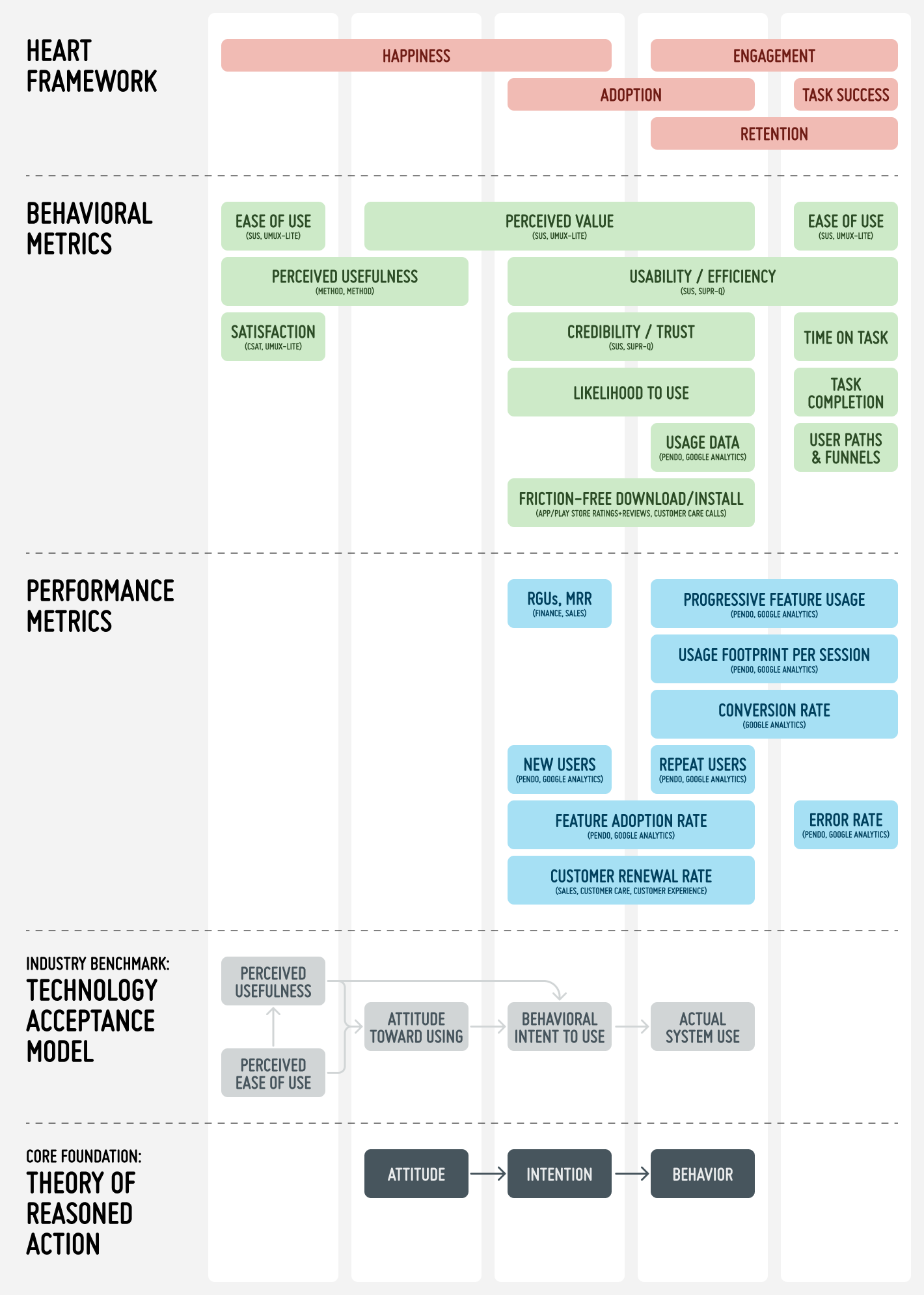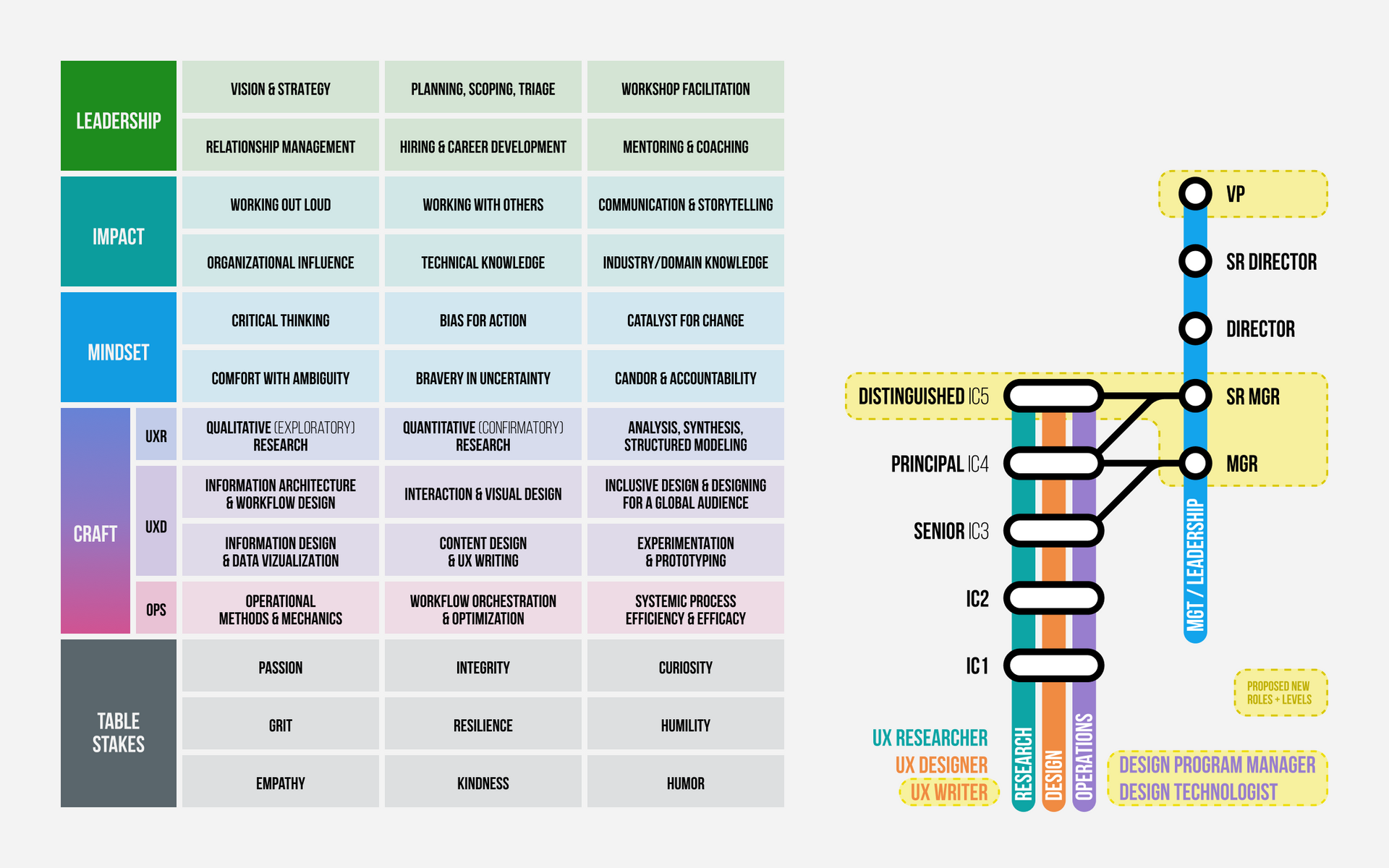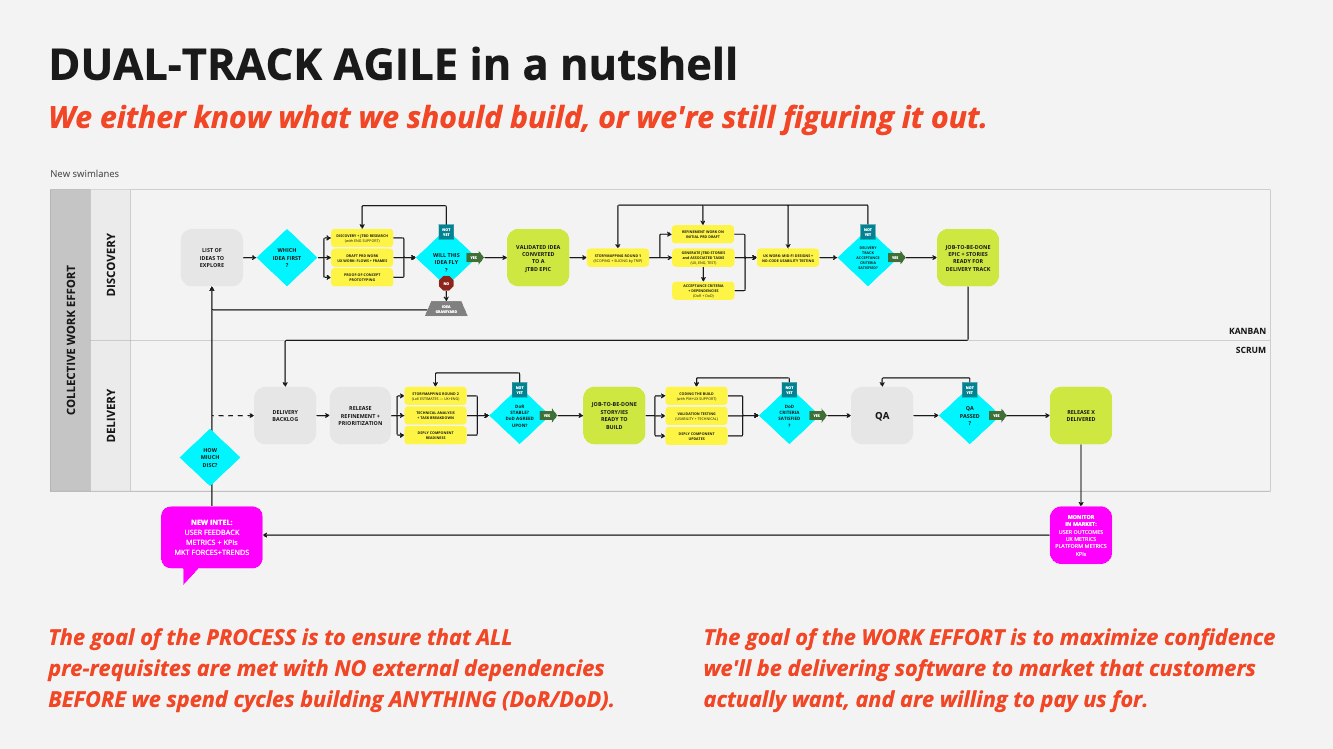On my first day at Zonar, my new boss concluded my office tour by asking me "so, where would you like to sit?" They were in the midst of a desk reshuffle, so he offered me a choice: one of two open desks near my team, or one outside his office — on the other end of the floor.
I thought about it for a moment and said
“Here's good. I feel like if my desk is over there, I’ll be disconnected from my team.”
This simple choice conveyed that my team was a top priority for me — a message implicitly understood by one of my new team members, who nodded in approval without a word.
- Established diverse career growth paths and equitable compensation levels for everyone on my team
- Repositioned UX as a strategic partner with Product Mgmt
- Introduced research tools & tactics to help Zonar Product Delivery make better-informed planning decisions
- Led Product Delivery to integrate systems thinking and dual-track agile into the DNA of how Zonar designs & builds products
- Expanded my scope of influence to Zonar's parent company by acting as functional manager for UX'ers in Continental EU
PHASE 1 : lead at the speed of trust
My first 100 days was spent listening and learning — in addition to simply getting familiar with Zonar and the industry they serve, I wanted to learn how Zonar thought about Design and UX overall.
But first, I wanted to dig into what my team thought about their role in the organization. Clearly they were ready for me, because they all shared pretty much the same feedback.
Team physically scattered around the office; distractions abound thanks to open floorplan.
Designers assigned to Scrum teams, but not included or treated as “part of the team”.
Designers do not feel seen, heard or represented.
Since we were in the middle of a desk shuffle, the timing worked out perfectly. I worked with our Facilities team to reconfigure the "quieter side" of our office into a dedicated workspace for my team, where they could focus on deep-work when needed.
We also established an open and inclusive collaboration space for design critiques and brainstorming sessions. We treated it like a perpetual open house, and we were the hosts. Everyone was welcome to come participate in our new approach and rituals.
FUN FACT: 4x8 foot pieces of gatorboard act as pretty effective sound buffers.
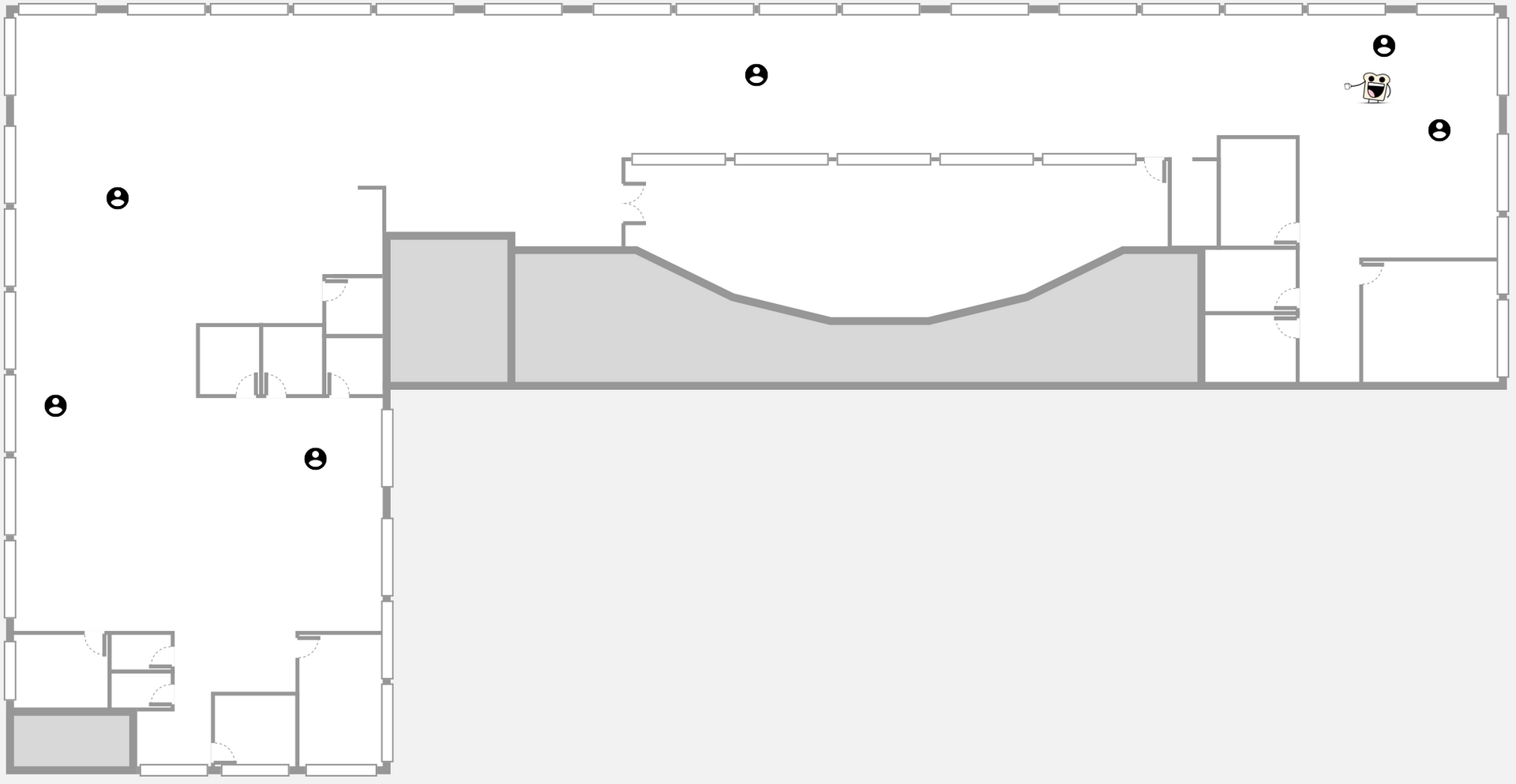
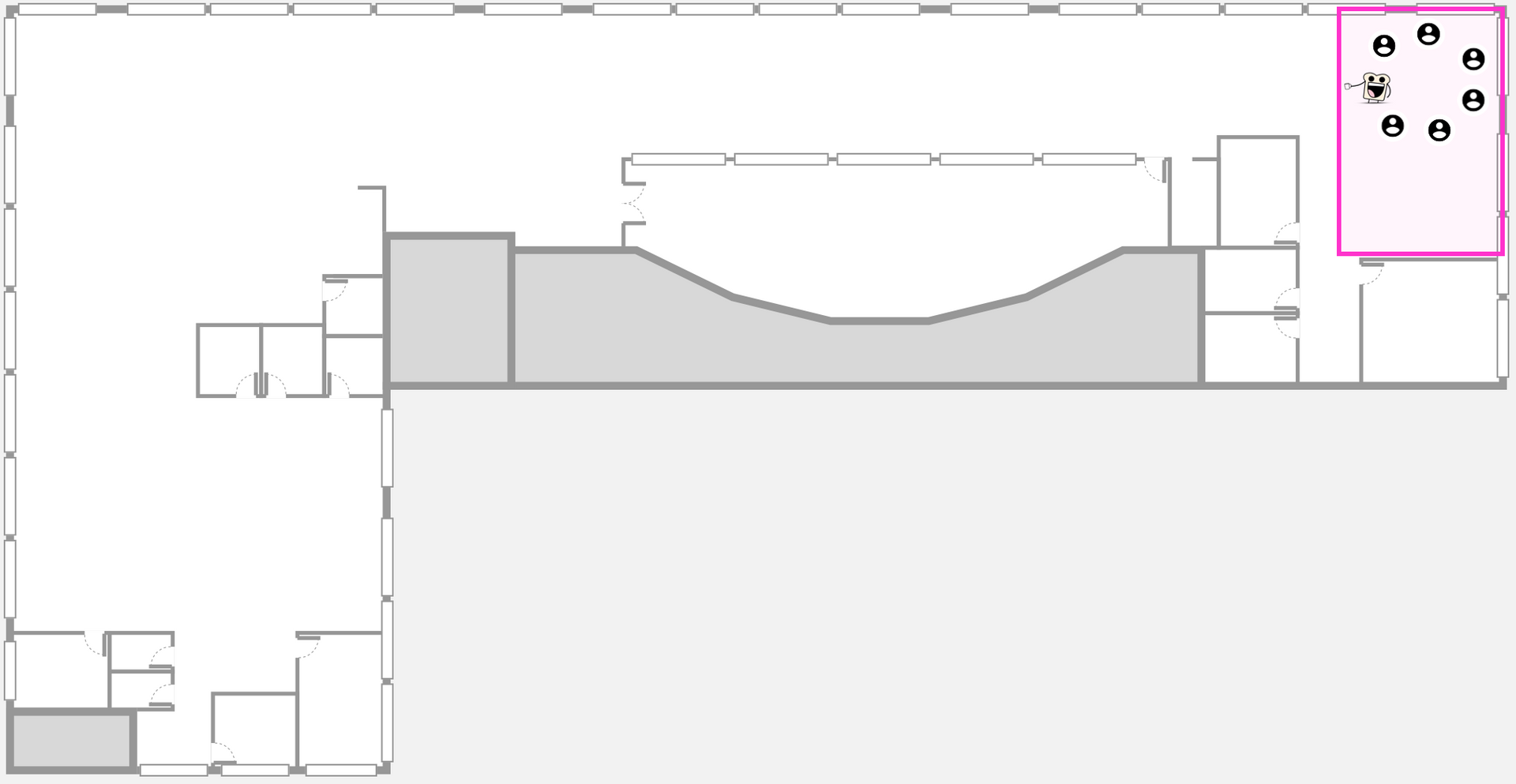
WE CALLED OUR NEW APPROACH "WORKING OUT LOUD"
Addressing the concerns around their physical work environment was all it took to get the team fired up about working on how we want to practice, think about, and talk about UX at Zonar.
Seek first to understand
I held a series of working sessions with my team to unpack all of the conscious and subconscious topics burning a hole in their brains.
- Looked at where UX lives in the org, got candid about what we should be doing vs what others think we (should) do, and identified areas for improvement.
- Established new team rituals to improve awareness of what everyone was working on, raise concerns, highlight opportunities for collaboration, and educate the broader org on our impact.
- Established a work status and "big ideas" board — visible to everyone in the office, and the gathering point for standups.
- Worked with peers and direct-reports on the first team charter.
Click image to enlarge
Evolve the UX discipline from tactical delivery resource to strategic partner
Own customer insights (research) and quality of experience (design) for Zonar
Address knowledge and proficiency gaps in the team (and the larger product org)
Educate Zonar on the expanded mission of the discipline, and the team's role/value
Modernize the usability and aesthetics of products & services within our ecosystem
Help Zonar evolve from a sales-centric startup to a global SaaS organization
PHASE 2 : MAKE BETTER DECISIONS FASTER
Mary Poppins famously said “well begun is half done”.
I’d begun the work to reinvigorate my team but knew that I was far from done. And I also had another challenge looming on the horizon.
The expectation for my role was to help Zonar learn how to be more design-led and evidence-driven — which made of one of my favorite sayings apropos.
During my first 100 days, the one thing everyone I spoke with could vehemently agree on was...
You think boiling the ocean is hard?
Try raising the temperature of the universe by two degrees.
Me
WE SUCK AT RESEARCH
...followed closely by "our UI is inconsistent and outdated" and "our products are on-prem & don't scale well"
In order for my team to have the confidence and credibility as leaders of customer insight, I needed to ensure that we had the right level of proficiency. I met with everyone on my team and evaluated their passion for and proficiency with various UX research methods.
That gave me a baseline for the team to take action in the form of:
Training resources to build proficiency
See one, do one, teach one to build
confidence
Buy-in and tie-in to build
advocacy
Score some quick wins to build credibility
Over the course of 6 months, I was able to fill proficiency gaps, and identify those on my team that had the potential to eventually become Zonar's first official UX researchers.


Simplified before:after view of UX team shift in will-n-skill
How do we suck less at research?
Back to the whiteboards we went. My staff meetings usually include a working session component — pick a topic, work on it each week together, let it marinate in our heads for a bit, rinse-and-repeat until we reach consensus and a path forward on that topic.
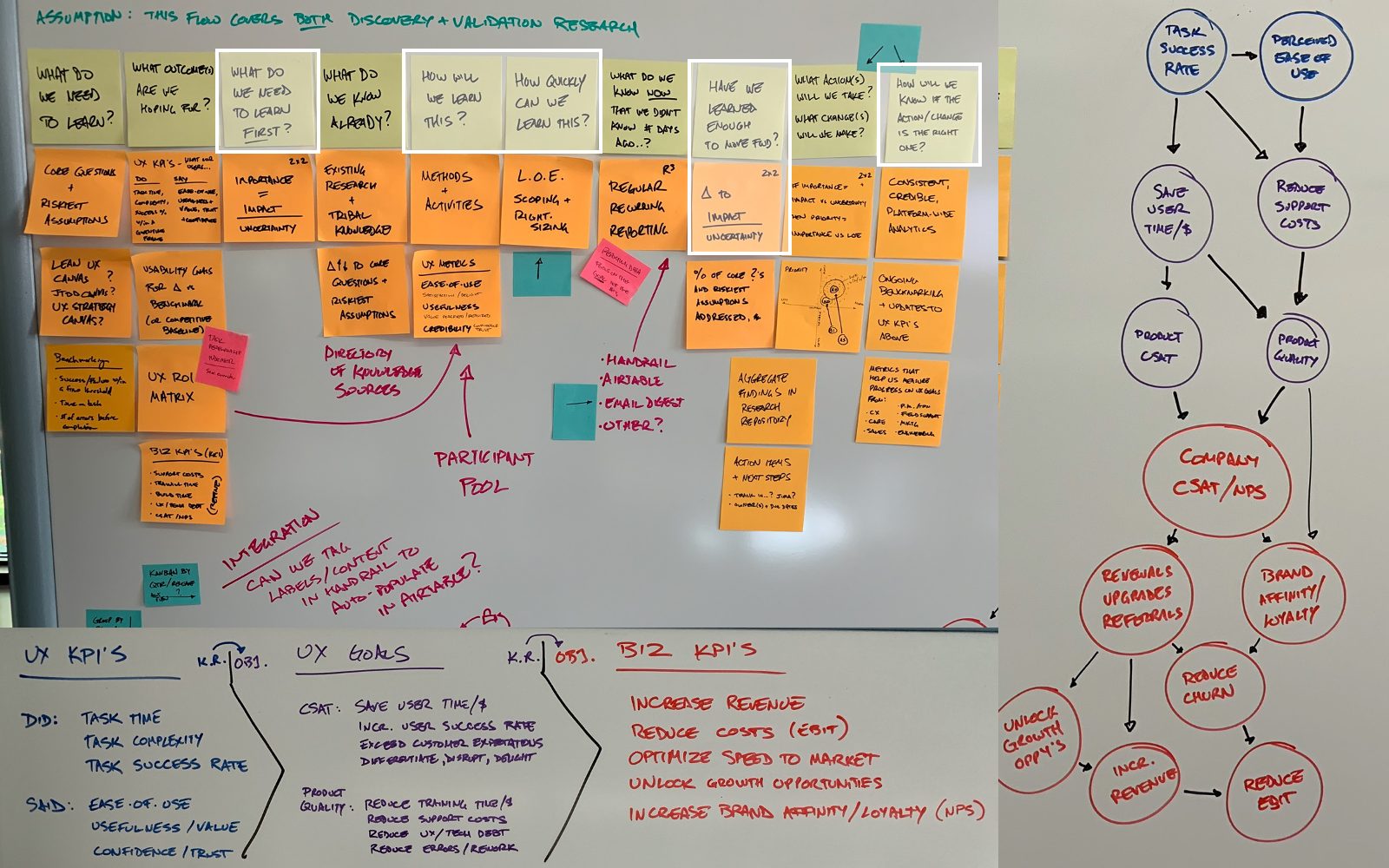
Because we were WORKING OUT LOUD — doing this at whiteboards visible to everyone else in the office — it encouraged then to come over and ask “what y’all workin on?”. Two Product Managers did just that, and ended up joining the conversation.
THREE HOURS LATER, these two PMs had helped us identify business KPIs they knew would resonate with Senior Leadership, co-authored UX GOALS using PM-specific LANGUAGE to encourage tie-in and buy-in. and helped us scope down to a subset of UX KPIs that (a) we could actually track at the time, and (b) would best support these goals, which gave us our “here’s how UX contributes to the things the business cares about” story.

Think big, start small, learn fast
We had identified the elephant in the room — improve our research capabilities in-house — but I also knew that trying to "eat the elephant" all at once would have been overwhelming for everyone.
I revisited resources I'd used in my prior role at Smashing Ideas, including one of my favorite reference articles from Dave Hora. In it, he maps out the career journey of a researcher within an organization, focusing on three growth axes:
- [Thinking] Process mastery: ownership of the research process
- [Execution] Technical competence: technique, method, and output
- [Impact] Organizational influence: empowerment, alignment, and direction
I also reached out to like-minded leaders in the org to build advocacy and adoption for new methodologies, introducing the following books as knowledge resources.
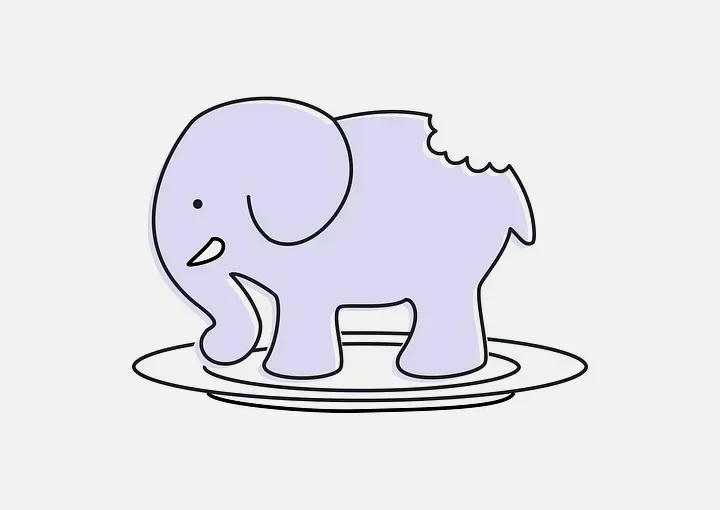
Conduct discovery research with both current & prospective customers on a regular basis — ideally weekly

Identify unmet customer needs & market opportunities to make products people truly want
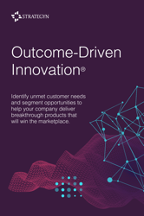
Focus on enabling the customers’ most important desired outcomes to maximize business impact
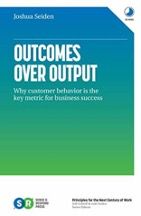
Understand the steps toward a desired outcome to make products that help customers reach it
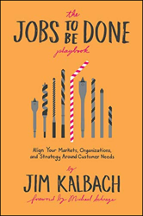
Conduct low-fidelity, low-cost, iterative experiments to solve customer problems together, faster
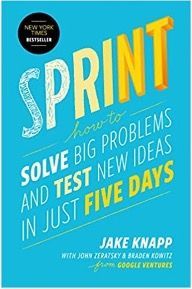
Align organizational efforts around the most valuable work to keep teams focused & engaged long-term
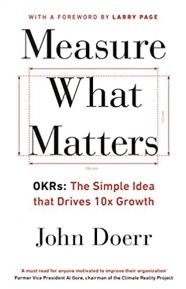
In order to make this elephant "more digestible" for the broader org — and to give my team a framework of sorts to categorize and plan the research work itself, I distilled the mission for what would eventually become my ResearchOps team into 5 core questions:
How well do we know our current & future customers?
How can we improve customers’ daily lives?
Can customers use our services successfully?
What business value do we expect these services to generate?
How quickly can we build and deliver these services?
needs, pains, goals, outcomes
usefulness, value, delight
comprehension, usability
growth, revenue, loyalty
feasibility, capability, velocity
Putting it into practice
In the spirit of see-one-do-one-teach-one, I led the strategic research efforts on a joint-venture between Zonar's vehicle inspection tool and Continental's tire pressure monitoring system — inviting my UX team to observe and contribute at every step.
I applied the Opportunity Landscape scoring model, which revealed that fleet managers' biggest pain-point was not having a reliable way to hold their drivers accountable for regularly checking tire pressure.
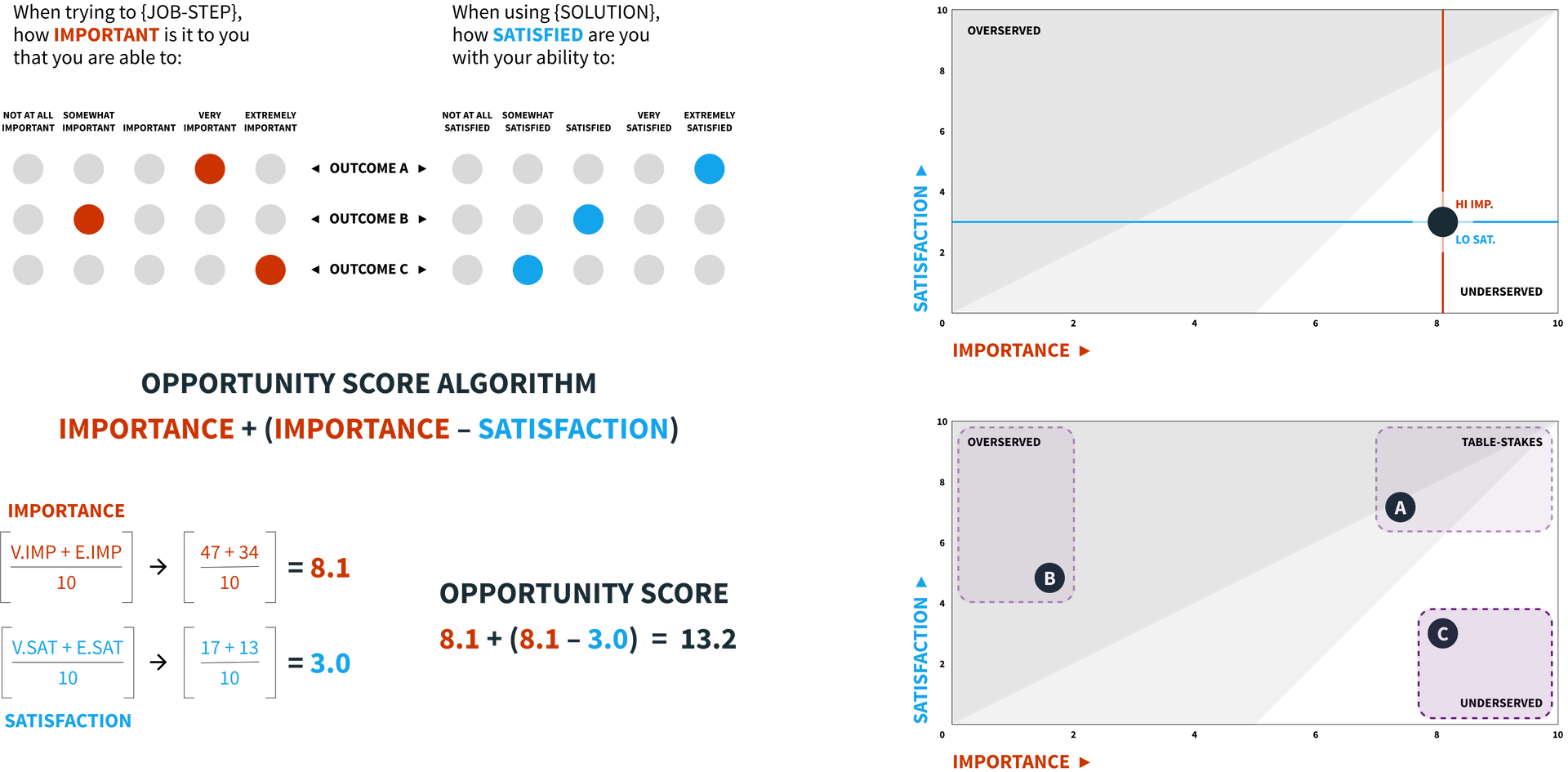
I used the Value-Prop Canvas with my PM partner to map out the Jobs-To-Be-Done, pains, and gains of our target customer groups (fleet/safety mgrs, drivers) and propose a mix of offerings that fit.
Imagery purposefully blurred in accordance with Zonar NDA
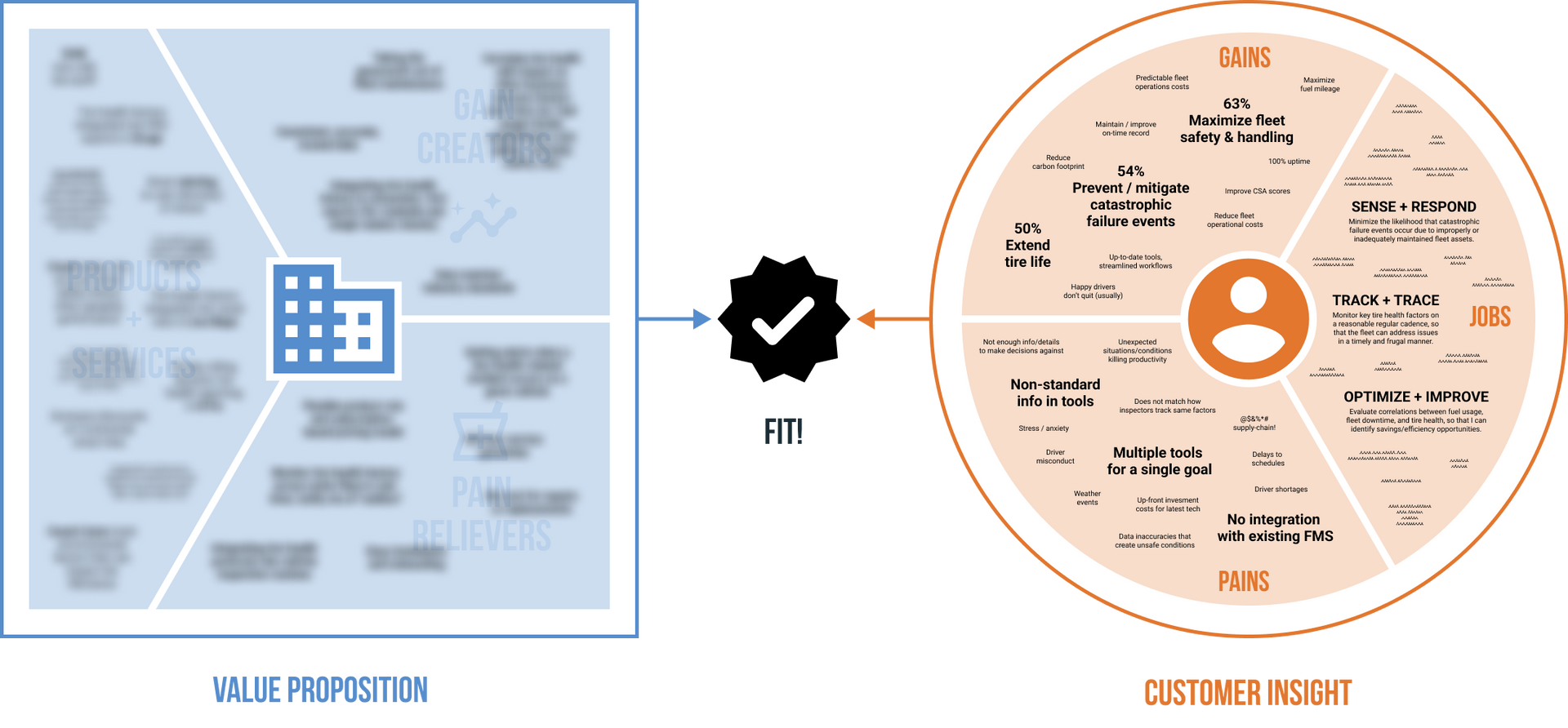
Launched a rolling cadence of 60-day pilot engagements for current and prospective customers to validate our research thus far; conducted Design Sprints & used the Ellis Score as a gauge of product-market fit.
Click the image to see the pilot program cadence map in full detail
I planned out a Continuous Discovery activity, and tapped one of the rising research stars on my team to facilitate and run it for 90 days, which helped us answer our three key assumptions.
Imagery purposefully blurred in accordance with Zonar NDA


PHASE 3 : OPERATIONALIZE + SCALE
Much of what I rolled out in this phase (which officially kicked off in Spring of 2022) is still a work in progress. There's a ton of contextual nuance and detail that's likely better received through an in-person conversation, but I'll endeavor to hit the highlights here:
Elevated the grass-roots initiative known as DSPLY (Design System, Pattern Library & You) to an org-wide commitment that fundamentally changed how UX+ENG work.

Worked with fellow leaders in PM, ENG, and TPM to forge a more integrated way of working that incorporated continuous learning into the rhythm of the business.
Established and rolled out the first formal set of behavioral and performance metrics for accurately & consistently measuring the quality of Zonar products.
Defined a career progression framework for the team that was both comprehensive and easy to understand, helping provide clarity on what excellence looks like for each role.
Hired 5 additional employees in 2022, including 2 UX Managers (and a promo made it 3), another dedicated researcher, and Zonar's first Design Technologist. Re-org'd the team around areas-of-focus. Tapped by Continental to hire, train, and lead 2 new UX'ers for their FMS team.
Began reporting directly to the CPO, and working more closely with the VP of PM to double-down on the strategic partnership between PM and UX.
Partnered with the Director of TPM, VP of Product, VP of Engineering, and over a dozen other leaders and stakeholders within the Zonar Product Delivery organization to define, evangelize, refine, and get buy-in on adopting Dual-Track Agile as our default methodology in 2024, making how Zonar gets products to market more collaborative, transparent, accountable, and efficient.
Whew. That was a lot, to be sure. Summarizing nearly 6 years of organizational leadership is no small feat, so thanks for making it all the way down here. If you're interested in hearing more about anything above, feel free to grab some time on my calendar.


